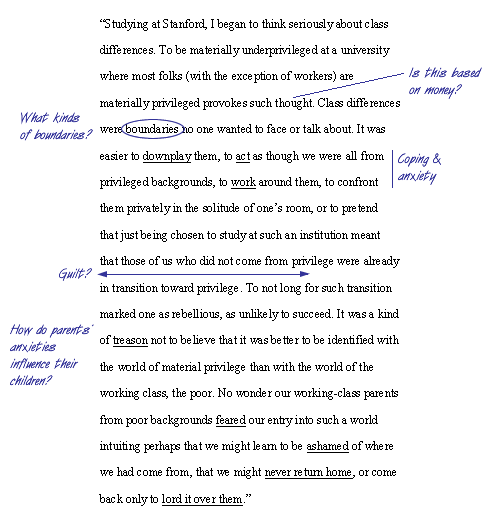Marking Your Textbook
Active Reading
Reading is an active process. Mark your text, take notes, and write notes in the margins. Marking or annotating a text is your response to what you are reading, and it might prove valuable to you later as you begin to organize and plan your essay. Marking a text is not the same thing as highlighting or underlining words: marking a text is your way of discovering what you find important, what you want to explore, and/or what puzzles you about a text.
Think of this process as having a dialogue with a text. Although the text cannot speak verbally, the written words communicate – sometimes the meaning is clear, while other times it is not. Your response, talking back to a text, can take place in your mind and also on the pages of text. As you underline, make notes in the margins, and raise questions, you are keeping a written record of your dialogue with the text. If you don’t record your reactions, the wonderful, insightful ideas or important questions you have while reading may be lost to you. If you annotate a text, you can return to it later to rethink what you consider important.
There is no one perfect way to annotate a text. Indeed, people will mark a text in different ways. Because each person creates her or his own reading, each person will find different points interesting, complex, or worth noting. Review the following annotated texts. Two students marked up this selection from Bell Hooks’ essay “keeping close to home: class and education.” Note the similarities and the differences – how might a reader use these annotations as a way to come back to the text for subsequent readings?
Before reading the following passage, turn to hooks’ text. Read the headnote and skim the essay in order to place the passage in context as you review the annotations.

Compare the two annotated texts. What does each annotator notice about the text? Are there patterns that emerge from the marking? Are there similarities between the two examples? Differences? What focus does each annotator seem to have? What are some issues each of these writers might explore in an essay about Hooks’ text?
Notice that the annotations in each example are marked with specific meaning. Annotating a text is a technique to help you become a more thoughtful reader. There is a danger, however, of marking or highlighting too much. Many students highlight nearly an entire page of a text; this does not enable the writer to come back to what was important to her or him, it simply gives the student a yellow (or blue, or… ) page. Think of marking up your text as the beginning of your dialogue with a text, which will lead you to an extended writing project. In this dialogue, you will be doing most of the work because as you ask questions, bring up inconsistencies, or try to explore ideas more deeply, you have to rely on the text and your reasoning to respond to your inquiry. If you read a text more than once, and some of these texts will require more than one reading, note the ways in which your annotations change. What seemed so puzzling the first time around, may make more sense with subsequent readings, or you may discover why a particular section seemed so important to you. Clearing up one point may lead to another question or to a conclusion. Class or small group discussions may give you insights or raise more questions or spark an interest in something you had not noticed before. This is an exciting process. Marking up your text is an integral part of the process. Thinking about and reviewing your annotations can be crucial as you move on to more extended and sustained writing.
Comfort, Carol. Breaking Boundaries, New Jersey: Prentice Hall, 2000.